- Management Plan
- Budget spent: £8,611
- Status: Implemented
The Lesser Kestrel (Falco naumanni) is a small falcon that historically, was one of the most abundant birds of prey in Europe. The latter half of the 20th century saw the bird fall from grace as their numbers dramatically declined. Over the last 30 years, there’s been a huge effort to conserve the species in Europe and now populations are recovering. Still, there is a lack of data, especially on the high rate of juvenile mortalities, which is why we’re funding the GPS tagging of juvenile Lesser Kestrels. This project presents an opportunity to start filling the knowledge gap on this small, but no ‘lesser’ bird of prey on its remarkable migration patterns.
More about this elegant raptor
Before explaining the intervention of this project, let’s take a closer look at this unique bird of prey and why it has drawn the attention of conservationists.
A Species that Spans Continents
Physical description
As their name suggests, the Lesser Kestrel is smaller than the Common Kestrel at 27-33cm in length and with a wingspan of 63-72cm (versus the Common Kestrel’s 32-39cm length and 65-82cm wingspan). Males are distinguishable by their chestnut back and a blue-grey crown, neck, rump, and tail. Their belly is a creamy pink with small brown streaks. While females have brown backs and head with a pale belly, and a streaked brown belly and back. Juveniles are more similar to females.
Migration, habitat & diet
Lesser Kestrels are a migratory species, breeding over a large range covering the Western Palearctic south and wintering in Africa. The largest congregations of wintering Lesser kestrels have been discovered in Senegal, Mauritania, West Mali and Niger. They migrate in small or loose flocks at around 2,000m above sea level.
In Europe, their habitat includes lowland areas with steppe-like grasslands and farmland where there are open areas for them to hunt. They don’t favour dense forests, vast treeless wetlands and mountains.
In terms of hunting, they are very adaptable, taking advantage of whatever’s on offer and make use of their strong beak and sharp eyesight and claws. They mainly eat a variety of large insects like grasshoppers and beetles but also voles, shrews, birds and lizards to name a few. Known for being opportunistic at farmlands, they hover above scoping their prey in a memorising manner. The sheer variety of animals they catch gives the Lesser Kestrel an important role of regulating other species on the food chain. They often heap praise from farmers for their ability to catch a number of crop-damaging animals.
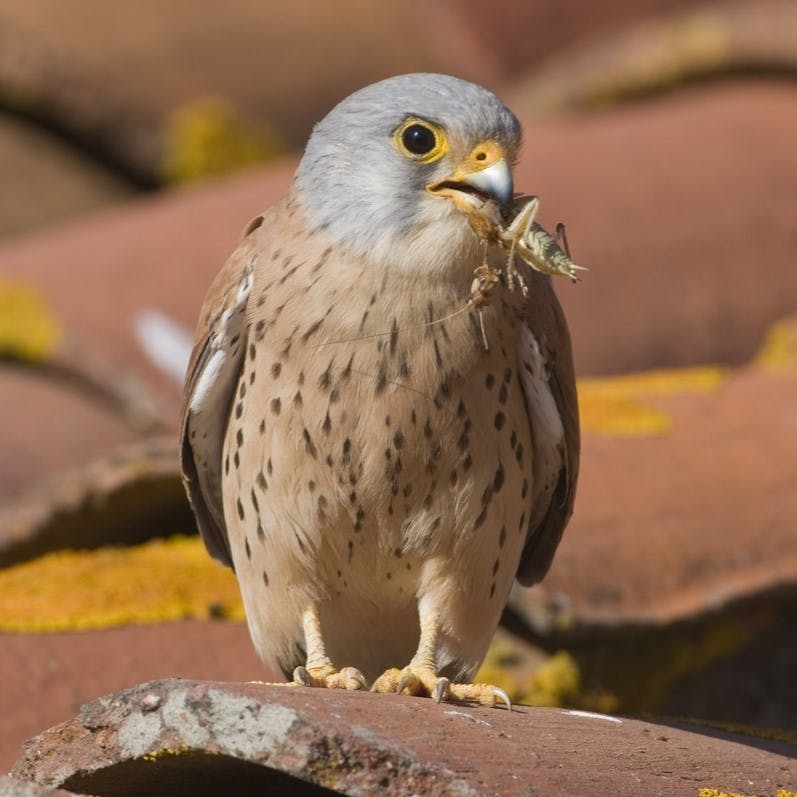
Nesting & Roosting
In their European range, they nest in human settlements with colonies found in walls or roofs of old houses, farm buildings, churches or castles, rock or sand cliffs, and quarries. Being a social creature they breed in colonies and roost communally in trees, often thousands in the same tree. A roost in Senegal was recorded to have 28,600 Lesser Kestrels and 16,000 African swallow-tailed kites - that’s some gathering!
Populations today
Current populations are estimated at less than 100,000 breeding couples globally, with 30,500 to 38,000 in Europe. Of this European population, 10% are thought to be in Spain. After almost 2 decades of conservation projects targeted at the Lesser Kestrel, their status was upgraded from ‘Vulnerable’ to ‘Least concern’ on the IUCN red list.
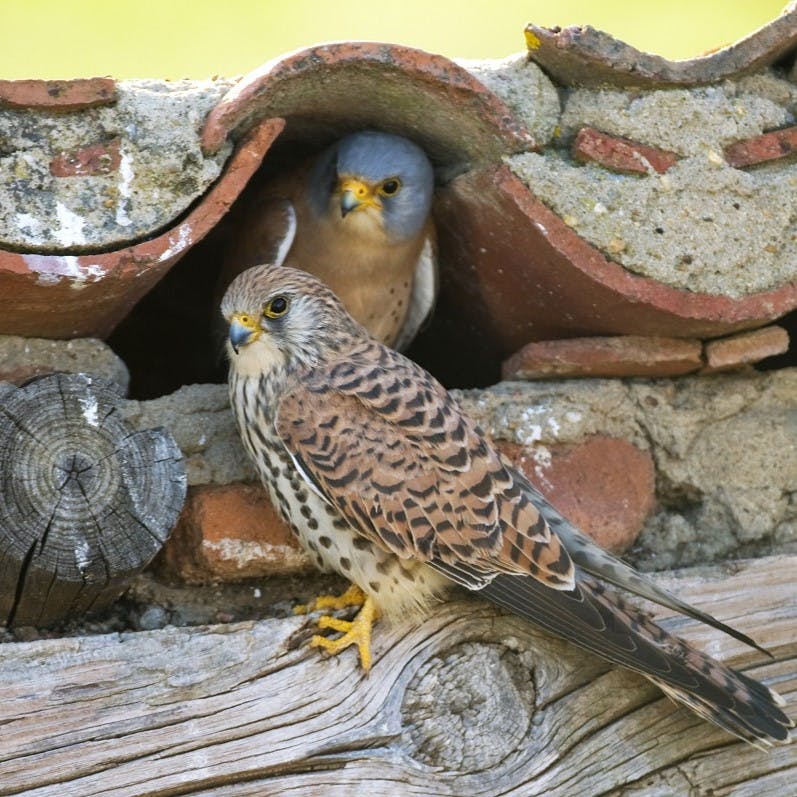
The Threats & Why They Need Help
The loss of habitat in its Western Palearctic breeding grounds is what drove the Lesser Kestrel’s dramatic decline last century. This was mostly attributed to the growth in agricultural land, but also afforestation of low-productive farmland with wood plantations, land abandonment and urbanisation. All of these factors have reduced their natural hunting grounds. The story is similar at migratory sites in South Africa where grasslands were replaced with farmlands.
Further to this, kestrels lose nesting sites in places such as old buildings, when they are neglected or restored. This leads to the birds seeking alternative nesting sites which aren’t safe from predators. It also puts them at greater risk of extreme temperatures and their chicks falling out of nests. High rates of chick mortality that have been recorded during unusually hot weather is another concern amidst rising global temperatures. Threats could also include pesticide or rodent poisoning.
Although the Lesser Kestrel’s status is ‘Least Concern’, the high rate of juvenile mortality and lack of data on why this is happening has raised concern amongst conservationists. This is why we’re dedicating our efforts to gaining a better understanding and safeguard the species’ populations.

Our Project
Thanks to the support of our members and our long-term business partners, inlumi, we are funding the GSP tagging of 4 juvenile birds to be released in the Fuente de Piedra Nature Reserve in Andalucia, Spain in 2022.
Our intervention falls within the monitoring component of the Lesser Kestrel conservation project developed by Defensa y Estudio del Medio Ambiente (DEMA). As far as our partners, DEMA, is aware, this is the first time juveniles have been tagged with GPS trackers and aims to provide valuable new information on:
- Important areas for the birds during the breeding season in Spain, such as key feeding areas
- Causes of mortality
- Important areas for the birds after the breeding events in Spain
- Migratory routes to Africa
- Wintering areas in Africa
The data gathered, including mapping, could aid the design of new conservation strategies and policies whilst contributing to research of the species. Additionally, DEMA will be able to use this technology as an effective tool to raise general public awareness of this important bird of prey and its role in the ecosystem.
Our collaboration with DEMA is the first time they will be using a GSM network for GPS tagging. This means the birds’ location can be accessed daily during both breeding and migratory seasons where in the past tracking only occurred as birds came within distance to antennas. In addition to purchasing the GPS trackers, we have covered some labour costs needed to monitor the project.
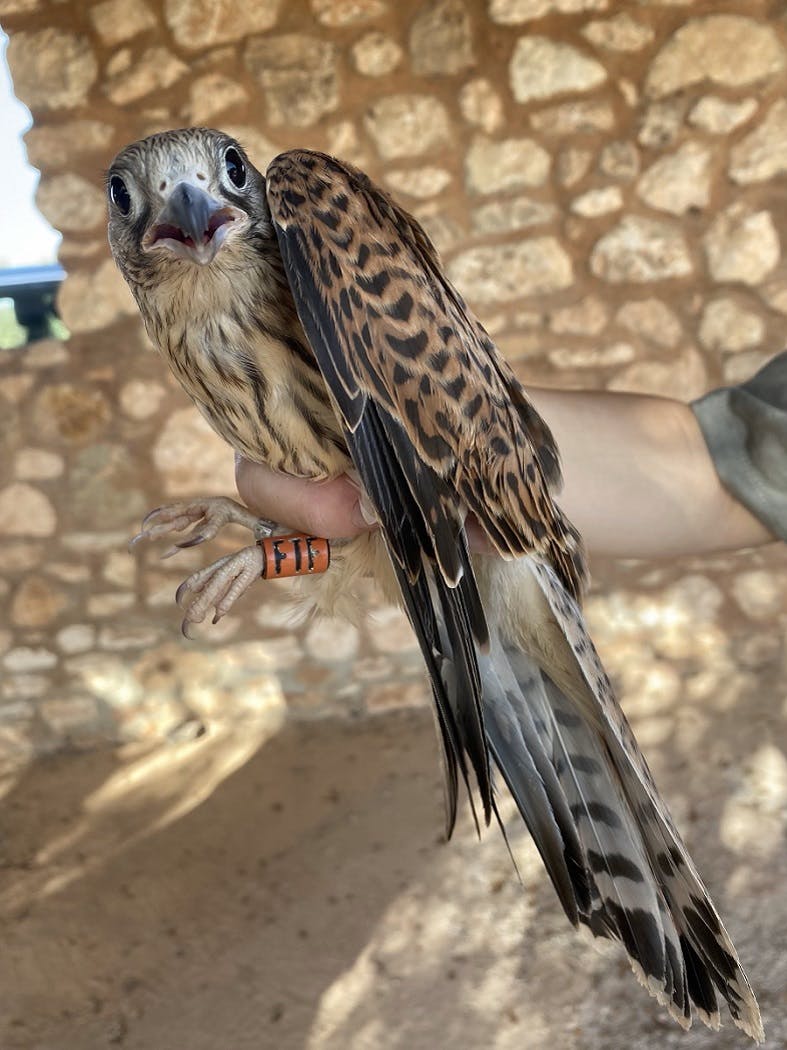
The Wider Project
Over the last 31 years, DEMA has dedicated work towards reinforcing the bird’s populations across Europe at their Lesser Kestrel breeding centre. They aim to bolster the breeding colony in the Fuente de Piedra Nature Reserve in Andalucia by breeding and translocating nestlings to be released in the reserve.
The captive breeding programme uses adults not capable of surviving in the wild and adopts an innovative methodology called ‘Colonial Environment’. This involves unique purpose-built breeding towers called ‘primillars’ (see below) with specially designed nesting boxes, anti-predation devices and nets to catch falling chicks. The centre’s plan is to release 170 Lesser Kestrel nestlings over a 4-year period, which began in 2021 with the first migratory returns expected in 2022.
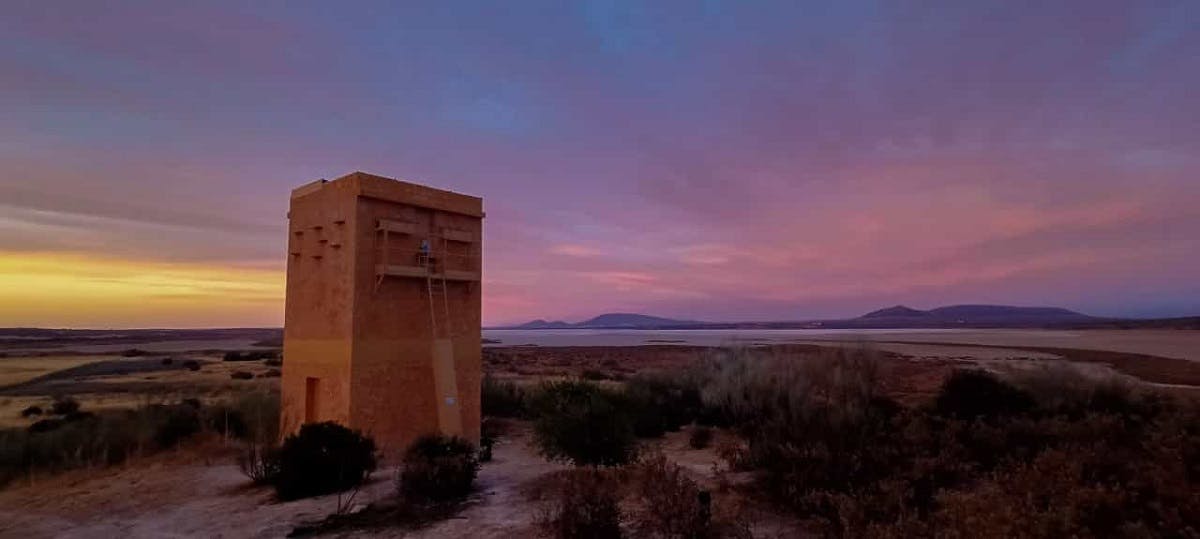
GPS Tagging Juveniles: A key component of the wider project
Effectively monitoring the newly fledged nestlings once they head out into the wild is vital to the success of the project’s aims. Using GPS tagging enables us to gather detailed data on their movements and gain new insights into potential threats the young birds come across on their journeys.
Upon reaching an appropriate age (6 weeks old) and size (150g), the juvenile kestrels are fitted with non-invasive loggers weighing 5g and secured like a backpack with Teflon ribbons across the bird’s breast. These ribbons are designed to naturally release after 2-3 years.
Monitoring the birds in this way has the possibility to produce unexpected results that can reveal new information on a species’ behaviour. As illustrated by a previous DEMA project to GPS tag the Iberian Imperial Eagle. Tagged in Spain, the eagles were tracked surprisingly crossing the strait to north Africa where a number of birds were electrocuted at a faulty electric pylon. The use of this technology not only allowed DEMA to work with the relevant entities to address the problem, but it also shed new light on the dispersion area of the eagle.
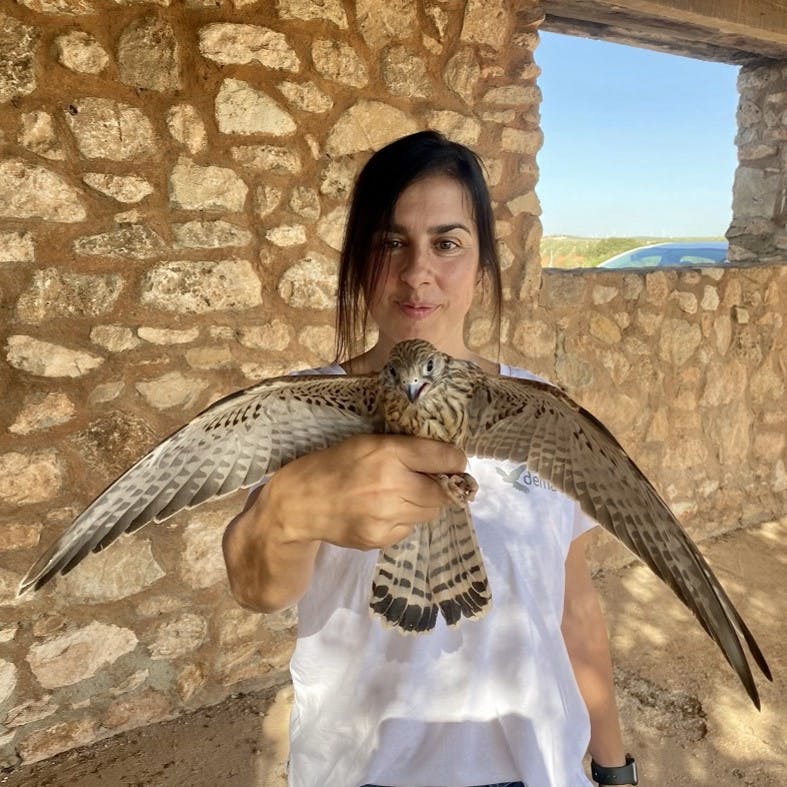
Stakeholder Engagement
The collaborative effort to conserve the Lesser Kestrel comprises a network of entities across Spain and further afield. Should the GPS tagging detect a mortality of a bird, DEMA will work with various Spanish bodies, including environmental rangers and the government, to investigate. For incidents abroad, DEMA has established contacts with local entities (such as in Senegal and Morocco) and will form new connections where access is needed. The data provided by the loggers will also be shared with Doñana Biological Station, a leading investigation centre.
Raising awareness of the project and why we’re protecting the Lesser Kestrel is an important element of DEMA’s objectives. To this end, young students will have the chance to participate in the release of the nestlings from the primillar to help stimulate public interest.
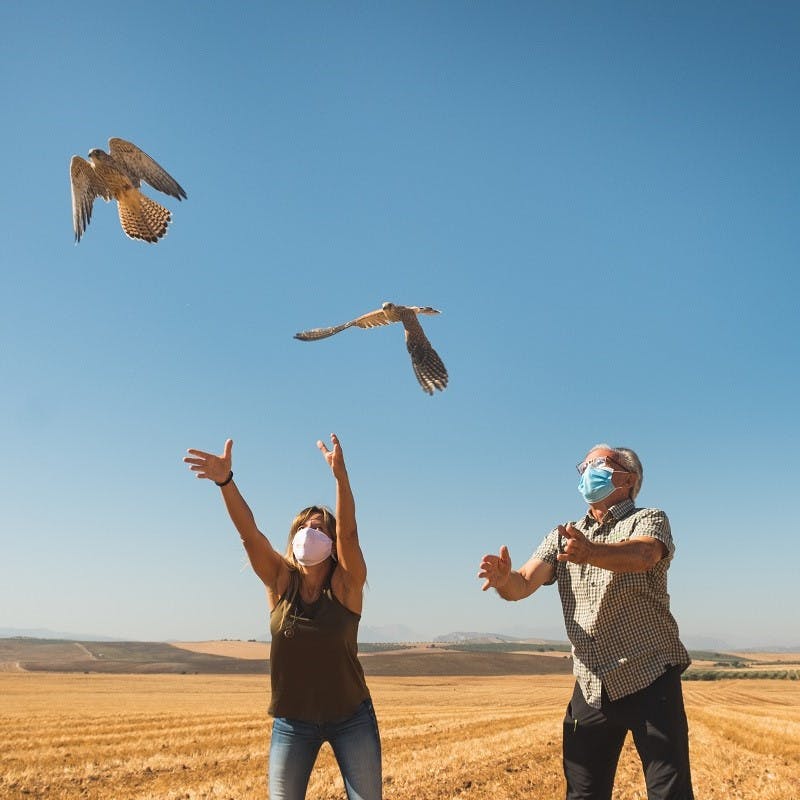
Upcoming Updates on the Kestrels’ Whereabouts
The teams at Mossy Earth and DEMA are excitedly anticipating the updates as they are transmitted back, which we’ll be sharing with you here. Our co-founder, Matt, has some news about the first update which both surprised and confused us! Be sure to watch our project video below to find out more.
Update October 2022
After an insightful eight weeks of GPS data since Mossy and Lumi were tagged, their GPS trackers have unfortunately stopped sending us data. It appears there has been a malfunction in both devices. It does not mean that the birds have died or come to any harm. Usually, if a tagged bird dies, the transmitter continues to send us data which allows us to find out where and when it has died.
The supplier has informed us that temporary malfunctions are not uncommon and that the trackers may resume operation in the coming weeks. However, the technology is relatively new and small, so long-term operation is not guaranteed.
While it's frustrating to lose the ability to monitor Mossy and Lumi's movements, we were able to gather valuable data on their initial movements, hunting areas, and pre-migratory behaviour.
Update 2023
Unfortunately, the two remaining tags intended to be used in 2023 were not operational and could not be fixed. This means that DEMA was only able to tag and track Mossy and Lumi, not the four kestrels originally planned.
Although this was a sad outcome, the data collected from Mossy and Lumi during those crucial eight weeks has still provided valuable insights into kestrel behavior, particularly regarding their movement patterns and pre-migratory habits. Research is always a learning process, and while setbacks are inevitable, each experience brings us closer to improving our understanding of these small creatures.
We remain hopeful that advances in technology will allow for more reliable tracking in the future, enabling dedicated teams like DEMA to continue studying and protecting these incredible birds.
Sources & further reading

- “Species Action Plan for the lesser kestrel Falco naumanni in the European Union” - European Union